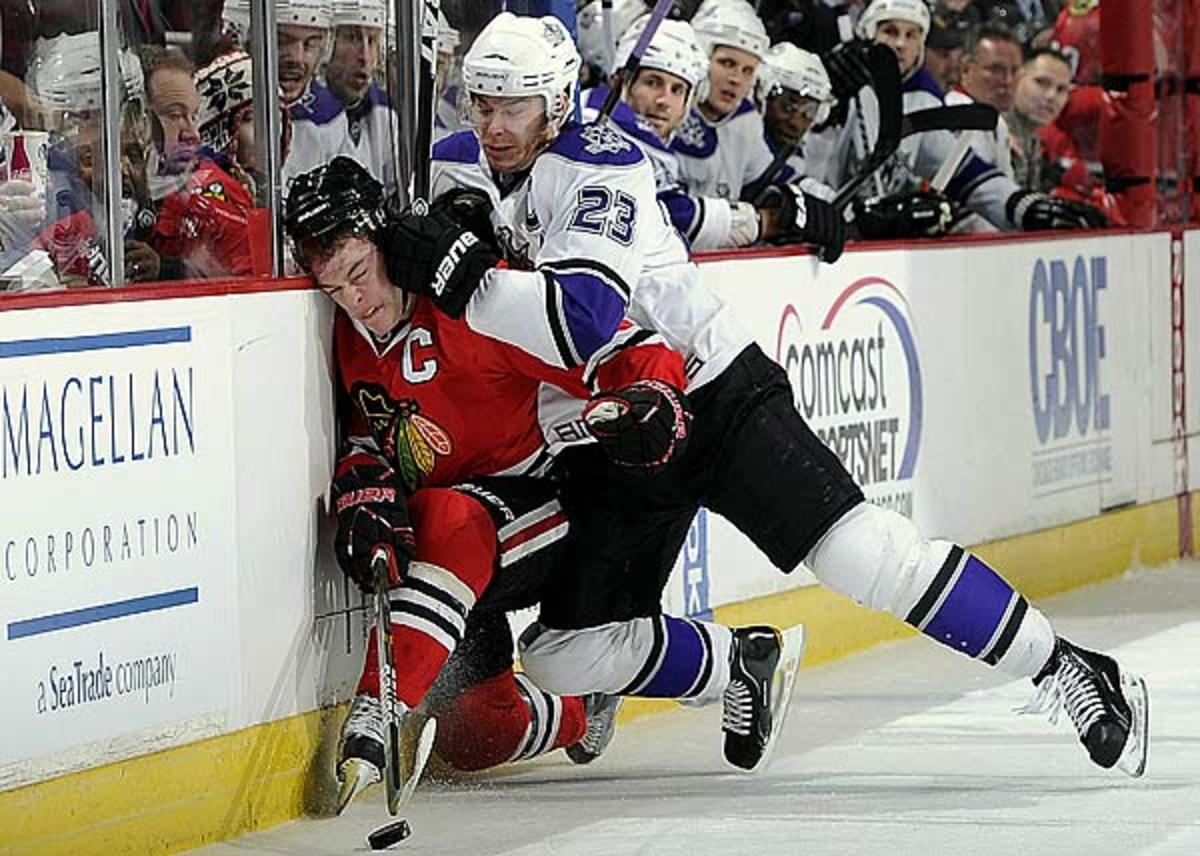Jonathan Toews wins Selke, underlines importance of the two-way trophy
Jonathan Toews won the 2013 Selke award, given to the season's best two-way forward. (Todd Rosenberg/SI)
By Sarah Kwak
CHICAGO -- The NHL announced just some of their award winners Friday afternoon, sort of second-tier accolades that included GM of the Year (Pittsburgh’s Ray Shero), coach of the year (Ottawa’s Paul MacLean) and the Lady Byng Trophy (Tampa Bay’s Martin St. Louis), given to the most gentlemanly player in the league. It seems that these are, perhaps, less important than the Hart, the Norris or the Vezina Trophy.
Now consider the Selke Trophy, which is supposed to be awarded to the best defensive forward in the game. But as it’s morphed into an award that acknowledges the best two-way forward, the Selke has become one of the most important awards in the NHL, one of the best indicators of the success of the recipient’s team.
Just look: this year’s winner is Blackhawks captain Jonathan Toews, now going after his second Stanley Cup in three years; and the 2013 runner-up? Boston’s Patrice Bergeron, going for his second Cup in two years. It may seem coincidental, but it’s not a fluke.
Looking back on the Stanley Cup finals since the 2004-05 lockout, the Selke Trophy winner has played in the final series in five of those seasons, including the current one: Rod Brind’Amour in 2006; Pavel Datsyuk in 2008 and ’09; Ryan Kesler in 2011; and Toews now. Look at the Cup winners in that same span, and each team, with the exception of Pittsburgh in 2009 and Los Angeles last spring, had a forward that finished in the Top 5 in Selke voting.
Meanwhile, only three finals have included the Norris winner and just two have included the Vezina winner or runner-up. And no player has lifted the Cup in the same year he won the Hart Trophy. A couple of Hart runner-ups have played in the Cup final (Daniel Sedin in 2011; Evgeni Malkin in 2008 and ’09), but it’s not a routine occurrence. Selke finalists, on the other hand, often seem to be around at the end of the NHL season.
It’s clear evidence for the extreme importance of two-way play as the season presses on and on. And there are no two better examples of that than Toews and Bergeron, a pair of centers that share many of the same characteristics on the ice: strong face-off numbers, excellent vision, extraordinary effort and 200-foot ice awareness. It shouldn’t come as any surprise, then, that they have been able to lead their respective clubs to the Stanley Cup finals (again).
Toews, who hasn’t had much offensive output this postseason (just one goal in 18 games so far), was instead an effective shutdown man against Chicago’s opponents in the West. He admitted perhaps giving Boston’s top line of David Krejci, Nathan Horton and Milan Lucic too much space and opportunity early in Game 1, when the trio scored a pair of early goals, but Toews helped shut that line down late in the game. Lucic, who had four shots in regulation, had zero in the overtime periods.
And while Toews has perhaps gotten more accolades and more recognition league-wide, Bergeron, since Boston’s Cup run in 2011, has proven to be just as effective -- if not moreso in the last two months. “Everyone was watching [Bergeron] at that point in [2011],” linemate Brad Marchand says. “With how well he played, shutting down [Vancouver’s] top line, it showed the world he deserved to be in that group [of Selke nominees]. It is a very elite group. [Three-time Selke winner] Datsyuk, obviously I think, is one of the best players in the league, and Bergy’s right up there with him.”
Bergeron’s attention to detail -- from his proficiency in the faceoff circle (best in the league) to his awareness of where his stick is on the ice at all times -- sets him apart and has helped quietly establish himself as one of the most well-rounded forwards in the league. He was a big reason the Bruins were able to silence Sidney Crosby and Evgeni Malkin in the Eastern Conference finals, and he’ll bring the same tight defense against some of Chicago’s top scorers, like Patrick Kane and Patrick Sharp.
“They’re capable two-way players,” Bruins center Chris Kelly says. “They play all three zones, and they play all three zones extremely well…They play the game the way the game should be played.”

































